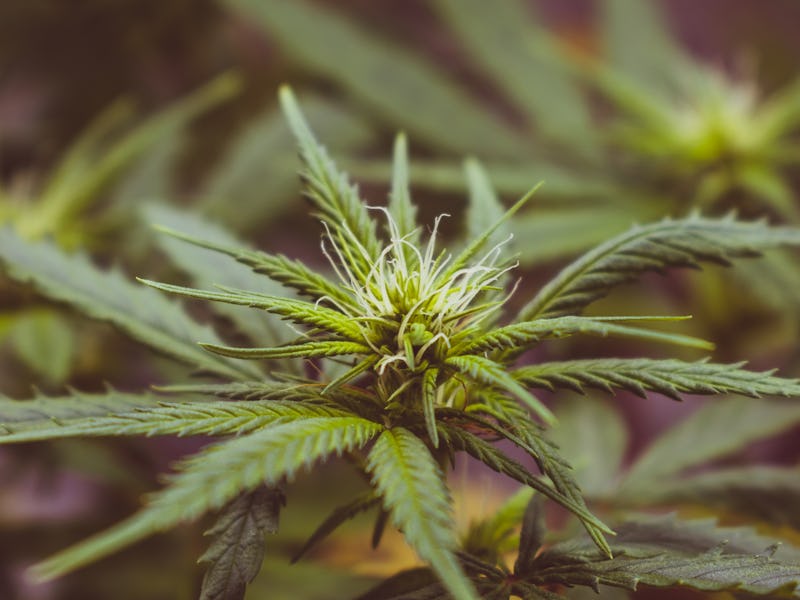Earliest Known Psychoactive Cannabis Use Discovered in 2,500-Year-Old Tomb
The cannabis that was used in these tombs contained high levels of THC.

Around the world, approximately 147 million people use cannabis. For many of them, the goal is to feel the effects of the plant’s psychoactive compound, ∆-9 tetrahydrocannabinol, better known as THC. While today it’s no mystery that marijuana can get you high, it’s unclear when humans made this discovery. On Wednesday, in Science Advances, an answer emerged: Humans have used cannabis for its psychoactive effects for at least 2,500 years.
That’s not to say ancient people were rolling blunts are the same time the Olmecs were building pyramids and the Persians sacked Athens. According to the study, people living 2,500 years ago in the Pamir Mountains of Central Asia were using cannabis for religious purposes. Its psychoactive properties likely served as a vehicle for communicating with the divine or the dead, the authors posit.
“I was surprised that the trace of biomarkers could still be preserved after burning and burial for about 2,500 years,” co-author and University of Chinese Academy of Sciences researcher Yimin Yang, Ph.D. tells Inverse. “I think [that’s] mostly due to the dry climate in the cemetery.”
Marijuana remains were found in an ancient cemetery in the Pamir Mountains, in Central Asia.
The religious hypothesis developed by Yang and his colleagues stems from the location where the THC compounds were discovered: Inside ten funerary incense burners, located in an archeological site known as Jirzankal Cemetery in the Pamir Mountains. The compounds, which were extracted from wooden fragments and burnt stones with gas chromatography-mass spectrometry, represent the earliest evidence to date of cannabis being used for its psychoactive properties.
The excavation of the tomb.
Yang says it’s likely that the tombs were the incense burners were found belonged to the Scythians, a group of nomadic warriors whose influence once ranged from China to the northern Black Sea. While now the Pamir region is considered remote, it’s speculated that it was once an important stop along the early Silk Road.
It’s possible that people started using cannabis for its psychoactive properties in this area, then the practice spread along the exchange routes.
What’s less clear is whether the compounds Yang’s team found came from wild cannabis or whether the people who used these tombs were ancient weed farmers. Wild cannabis does grow in the well-watered habitats of Central Asia, but, crucially, the levels of active compounds (known as cannabinols) in most wild cannabis plants are low.
How, then, did the owners the funerary incense burners get marijuana potent enough for psychoactive use? The cannabis that was used in these tombs contained high levels of THC, and the compound’s presence is extreme enough to imply purposeful selection.
One theory outlined in the paper is that UV radiation causes cannabis at higher elevations to produce greater quantities of active compounds — so it’s possible that the people who roamed the Pamir Mountains were simply exposed to more potent wild plants.
The type of stone containing funerary burner referenced in this study.
The evidence suggests that the plant was burned during rituals that commemorated the dead. The incense burners that contained the cannabis were found among black-and-white stones that seemed deliberately arranged in rings. These are signs that the people who cared for these tombs made purposeful decisions when it came to honoring people who had died.
Yang isn’t certain how the ancient strains compared to modern strains of cannabis, explaining that “it’s forbidden to own drug-type cannabis in China.”
This study adds credibility to the stories told by the Greek historian Herodotus, which described the ceremonial, psychoactive plants used by the Scythians. It also demonstrates how long and complex the history of humans and cannabis really is. Cannabis plants have been cultivated for textiles and oils since about 4,000 B.C., but now it’s clear that early societies didn’t let its psychoactive properties go to waste.
In 2019, cannabis is big business, with an abundance of marijuana-laced products and branded strains — but it all had to begin with someone realizing it had trippy properties at all.
Abstract:
Cannabis is one of the oldest cultivated plants in East Asia, grown for grain and fiber as well as for recreational, medical, and ritual purposes. It is one of the most widely used psychoactive drugs in the world today, but little is known about its early psychoactive use or when plants under cultivation evolved the phenotypical trait of increased specialized compound production. The archaeological evidence for ritualized consumption of cannabis is limited and contentious. Here, we present some of the earliest directly dated and scientifically verified evidence for ritual cannabis smoking. This phytochemical analysis indicates that cannabis plants were burned in wooden braziers during mortuary ceremonies at the Jirzankal Cemetery (ca. 500 BCE) in the eastern Pamirs region. This suggests cannabis was smoked as part of ritual and/or religious activities in western China by at least 2500 years ago and that the cannabis plants produced high levels of psychoactive compounds.